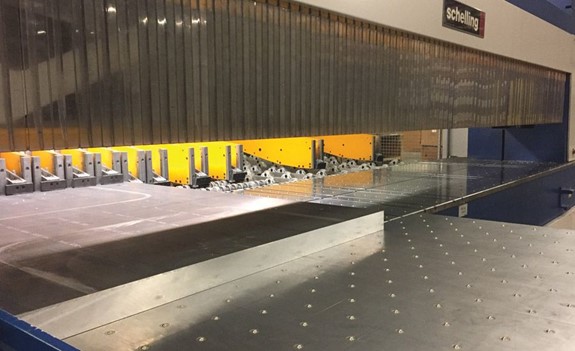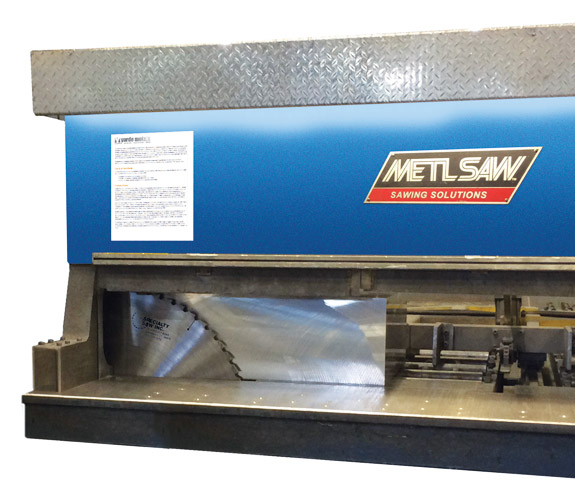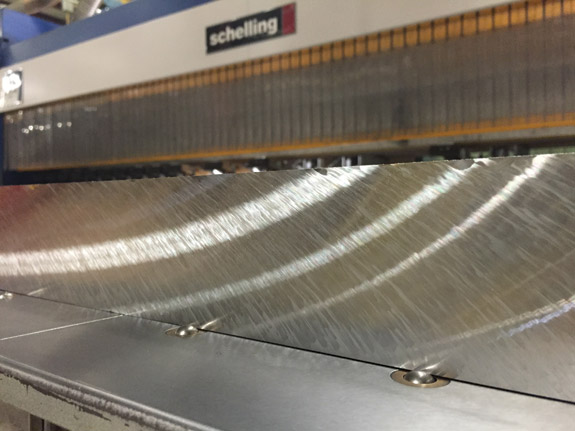
Above: Specialty Saw offers carbide-tipped saw blades for nonferrous material, designed for plate saws built by Schelling, MetlSaw, B&O and Stone.
From speed to tooth count, the saw blade is every bit as crucial as the machine that runs it
August 2016 - If you’ve ever had a job interview or performance review, chances are you’ve been asked some variation of the question, “How did your greatest weakness become your biggest strength?” Aside from nervous reassurances that your biggest weakness is you “don’t know how to turn it off” and can “be a bit of a workaholic,” it’s not the easiest question to answer. Often, a sincere recollection of a problem you faced and were able to overcome—all while learning from it—will suffice. Similarly, when examining shortcomings with equipment performance, the problem may require a deeper examination of each part of the process, exposing the obstacle that eventually becomes the source of strength.
In the case of thyssenkrupp Materials NA Copper and Brass Sales, the game changer lay in a saw blade. When one customer requested a mirror finish on its material, the Wallingford, Connecticut-based service center was prompted to look for a new kind of cutting tool. “We realized we were looking for a blade that four, five years ago, didn’t exist many places—as far as we knew,” says Waddie Silva, plant manager.
After a slew of calls, Silva came across Specialty Saw Inc., Simsbury, Connecticut. “They came here and [although] we weren’t really sure what exactly we were looking for, [they] worked with us until we found the right blade[that would achieve the required finish],” recalls Silva.
Following months of technical support and instruction, including tips on how to approach different jobs “and answering all of our crazy questions,” Silva says the easy relationship with Specialty Saw bore fruit. “After that, we switched over to Specialty Saw for all our blades.”
Beyond selling blades, Specialty Saw incorporates consulting and troubleshooting at no additional cost. “We provide an engineered solution for their sawing problems,” President Dave Nagy says.

Since switching to Specialty Saw blades, Copper and Brass Sales experienced a 50 percent increase in productivity.
Survey findings
To pinpoint the problems challenging thyssenkrupp, Specialty Saw had the company complete its Sawing Survey, which revealed the blades in question did not produce consistent results. “A lot of time was being wasted qualifying new blades, only to find out that the cut finish was poor,” says Nagy. “Many customers don’t even know the problems they are facing until [they’re] revealed by our comprehensive sawing survey.”
Common issues that the survey responses help to expose include problems encountered during robotic sawing processes, when the parts are moving while cutting castings; getting the best finish when cutting extrusions; doubling and tripling blade life by improving blade lubrication systems; reducing blade operating noise levels; reducing the number of blade teeth, which substantially lowers the cost of blade repair; and addressing clamping issues when cutting special shapes. “Ultimately, our goal is to provide customers longer blade life, best finish, quiet cutting and reduced overall cost,” Nagy says.
After switching to Specialty Saw’s precision cutting nonferrous blade (PCNF) and following the recommendations provided in the sawing survey, every new or resharpened blade is guaranteed by the manufacturer to repeatedly perform like new.
Productivity at Copper and Brass Sales’ sawing operation rose 50 percent thanks to reduced setup times, says Silva. “Our cut finish is drastically improved, and the blades always perform consistently,” he adds.
“The back-and-forth [communication] is so great we ended up recommending Specialty Saw to our sister company,” Silva says. Cutting a wide range of grades of aluminum and brass up to 10 inches thick, the metal processor’s blade consumption has decreased dramatically and blade costs have fallen 25 percent since making the switch to Specialty’s blades.
“We use a lot fewer blades even with the better finish,” he says. “That saves us money. Instead of going through 10 to 15 blades a week, we’re down to five or six.”
Traceability is another benefit, as each one of Specialty Saw’s blades has a serial number. The manufacturer “keeps track of what’s happening with each blade to follow lifespan and determine if the current blade is meeting expectations. “If they have to fix or replace a blade, they know exactly why,” Silva explains. “They [monitor] how their product is serving us.”

Each blade is marked with a unique serial number, allowing Specialty Saw to keep track of blade performance.
Copper conundrum
Part of the follow-up provided by Specialty Saw included recognizing a one-size-fits-all approach wouldn’t apply to thyssenkrupp’s metal cutting operations. Cutting copper proved challenging at first because the blade would overheat and bend instead of staying rigid—critical to maintaining tolerances and a consistent finish.
“The blade would get way too hot and was cutting out of tolerance,” Silva says. Wedged in the material, the immobile blade was costing the company precious time. “We asked Specialty Saw if we were doing something wrong since our saw manufacturer said there was nothing wrong with the saw itself.”
Technical representatives from Specialty Saw looked into thyssenkrupp’s process and determined that since the copper was thin, the chips coming out of the blade were a lot larger, causing the blade to overheat. “They suggested an entirely different blade just for cutting copper,” Silva says. “By changing the geometry of the tooth, we would get more lubrication, resulting in better tolerances.”
Nagy believes the ability to solve problems is why saw manufacturers are calling his company from all across the United States. “We have saw machine manufacturers reaching out to us when selling to potential customers,” he says. “They want our blades on their machines [during demonstrations] to ensure that they perform at their highest potential.”
Specialty Saw offers carbide-tipped saw blades ranging from 10 to 88 inches in diameter, and recently released a line of carbide-tipped saw blades for nonferrous material that are designed for plate saws made by Schelling, MetlSaw Systems Inc., B&O Saws Inc. and Stone, among others.
In the Wallingford branch alone, Silva attributes the consistent results—across 50,000 pounds of material processed each day—to the combination of the right machines and the right blades.
The company’s multiple locations each handle aerospace orders, requiring repeatable results while adhering to stringent tolerances. “The blade improved both the finish and tolerance,” Silva says. “We have a lot of customers that require those tight tolerances and now have the added benefit of a mirror finish.” MM